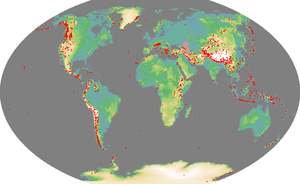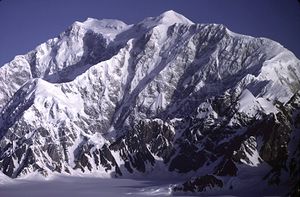قمة جبلية شاهقة
القمة الجبلية الشاهقة ultra-prominent peak هي قمة جبل بنتوء طبوغرافي 1500 متر أو أكثر؛ وتـُسمى أيضاً P1500.[1] There are approximately 1,524 such peaks on Earth.[2] Some well-known peaks, such as the Matterhorn and Eiger, are not Ultras because they are connected to higher mountains by high cols and therefore do not achieve enough topographic prominence.
The term "Ultra" originated with earth scientist Steve Fry, from his studies of the prominence of peaks in Washington in the 1980s. His original term was "ultra major mountain", referring to peaks with at least 1،500 متر (4،900 ft) of prominence.[3]
التوزع
Currently, 1,515 Ultras have been identified above sea level: 637 in Asia, 353 in North America, 209 in أمريكا الجنوبية, 119 in Europe (including the Caucasus), 84 in Africa, 69 in Australasia and 39 in Antarctica.[2]
Many of the world's largest mountains are Ultras, including Mount Everest, K2, Kilimanjaro, Mont Blanc, and Mount Olympus. On the other hand, others such as the Eiger and the Matterhorn are not Ultras because they do not have sufficient prominence. Many Ultras lie in rarely visited and inhospitable parts of the world, including 39 in Greenland, the high points of the Arctic islands of Novaya Zemlya, Jan Mayen and Spitsbergen, and many of the peaks of the Greater ranges of Asia. In British Columbia, some of the mountains listed do not even have generally recognized names.
Thirteen of the fourteen 8,000-metre summits are Ultras (the exception being Lhotse), and there are a further 64 Ultras over 7،000 متر (23،000 ft) in height. There are 90 Ultras with a prominence of over 3،000 متر (9،800 ft), but only 22 with more than 4،000 متر (13،000 ft) prominence.
A number of Ultras have yet to be climbed, with Sauyr Zhotasy, (possibly) Mount Siple, and Gangkar Puensum being the most likely candidates for the most prominent unclimbed mountain in the world.[3][4]
All of the Seven Summits are Ultras by virtue of the fact that they are the high points of large landmasses. Each has its key col at or near sea level, resulting in a prominence value almost equal to its elevation.
قوائم الشواهق (1515)
عام
- List of peaks by prominence gives the 125 most prominent peaks worldwide.
- List of islands by highest point gives the 75 highest island highpoints, all of which are Ultras
أنتارتيكا (41)
- List of Ultras in Antarctica, including South Atlantic islands (41)
آسيا (637)
- List of Ultras in West Asia (88)
- List of Ultras in Central Asia (75)
- List of Ultras of the Karakoram and Hindu Kush (61)
- List of Ultras of the Himalayas, including Sino-Nepal Provinces (76)
- List of Ultras of Tibet, East Asia and neighbouring areas, including India (112)
- List of Ultras in Northeast Asia (53)
- List of Ultras in Japan (21)
- List of Ultras in Southeast Asia (42)
- List of Ultras in the Philippines (30)
- List of Ultras of Malay Archipelago (92 including 12 in Oceania [Papua])
أفريقيا (84)
أوروپا (119)
- List of European ultra-prominent peaks, including non-Alpine European Ultras (60), the Atlantic islands (6) and the European Caucasus Mountains (10)
- List of the highest European ultra-prominent peaks (33)
- List of Alpine peaks by prominence (44)
أمريكا الشمالية (353)
- List of Ultras in North America (353)
- List of Ultras in Canada (143 ومنهم 6 على الحدود مع الولايات المتحدة)
- List of Ultras in the United States (129 ومنهم 6 في أوقيانوسيا [الجزر الهاوائية] و 6 على الحدود مع كندا)
- List of Ultras in Alaska (65 ومنهم 4 على الحدود مع يوكن و 2 على الحدود مع كولومبيا البريطانية)
- List of Ultras in Greenland (39)
- List of Ultras in Mexico (27)
- List of Ultras in Central America (23)
- List of Ultras in the Caribbean (7)
أوقيانوسيا (69)
- List of Ultras in Oceania, including the Southern Indian Ocean (69)
- List of ultra-prominent summits of Australia (2)
- List of ultra-prominent summits of Indonesian New Guinea (12)
- List of ultra-prominent summits of New Zealand (10)
- List of ultra-prominent summits of Papua New Guinea (31)
- List of ultra-prominent summits of the Hawaiian Islands (6)
- List of ultra-prominent summits of the Pacific Islands (6)
- List of ultra-prominent summits of the Southern Indian Ocean (2)
أمريكا الجنوبية (209)
انظر أيضاً
الهامش
- ^ Rob Woodhall (18 May 2016). "Relative hills on Earth". TheRelativeHillsofBritain.
Ultra: peaks with a minimum prominence/relative height of 1500m. Steve Fry coined the term Ultra in the USA in the 1980s. His original term was 'ultra major mountain'. There are no Ultra summits in Britain. Hall of Fame entry minimum is 15.
- ^ أ ب Maizlish, A. "The Ultra-Prominences Page". Peaklist.org.
- ^ أ ب Helman, Adam (2005). The Finest Peaks: Prominence and other Mountain Measures. Trafford. ISBN 1-4120-5994-1.
- ^ Maizlish, A. "Antarctic Ultra-Prominent Summits". Peaklist.org. (See footnotes 3 and 10.)

